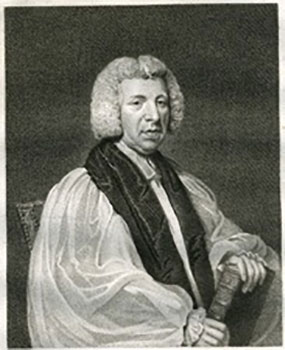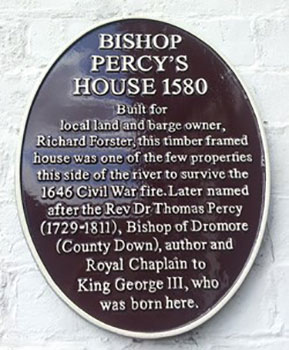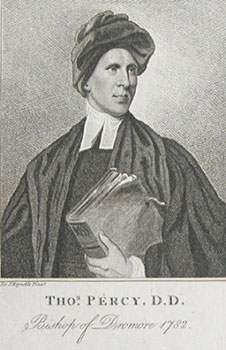Bishop Percy’s House was reputedly built in 1580 as commercial premises and residential home by Mr Richard Forster. (Often documented as Forester).
Richard Forster was a wealthy shipping merchant who chose its location because of its proximity to the River Severn. It was built on the lower end of Cartway, an area of Bridgnorth stemming back to medieval times when it was known as Cowgate, the actual building itself was in fact built around a medieval building that was very possibly a defensive tower. A lane led down from the house to a riverside wharf known as Forster’s Loade.
The house originally known as ‘Forsters Folly’, was built from oak posts and beams, many of which were sourced from old ships, with oak framing between the spaces. The original door locked with a substantial key, still in use today was to the left of the building.
Bishop Percy’s House was one of the few properties of its type to survive the great fire in April 1646 started by the Royalist garrison of the castle during the Civil War.
In 162 it was documented tin the earth Tax Assessment that the property had seven fireplaces and was occupied by Anthony Nott, who had succeeded Richard Forster as its owner.
By the 18th Century the properties recorded residents where Thomas Nott in 1712 and Mrs Nott in 1725. Then in 1727 the house became the property of Arthur Lowe Percy, a wholesale grocer and tobacconist from Worcester when he marries Jane Nott. Percy went on to become the bridesman of Bridgnorth in 1733, an alderman in 1737 and served as a town bailiff in 1742 and 1751, he passed away in 1764. Arthur Percy was best known as the father of Thomas Percy who was born in 1729 and went on to become the Bishop of Dromore. It was from here the house became known as Bishop Percy’s House.
By 1830 the property had undergone some structural work and a manuscript map of this time showed a long extension to the west of the property. By the middle of the 1800’s there was a brass and iron foundry at the rear of the property run by Charles Rushton and later by the Barker family. The house itself was described an 1856 by George Bellet as being a ‘neglected condition’. Much of the house was empty, parts of it being used as an iron foundry ad parts as a huckster’s shop.
In 1865 the house featured in a sale catalogue of the estate of Lord Sudeley, described as an Ancient Tenement as the Old House, a fine specimen of Domestic Architecture of the 16th century, famed as the birthplace of Bishop Percy. It contained three rooms, a Brewhouse, a warehouse and underground cellarage, and was occupied by Mrs H Barker. The yard contained a farrier’s workshop, a brick and tile warehouse, and a brick and tile engine house. It was noted that the premises were not in a good state of repair.
An Ordinance Survey map of 1884 showed the brass and iron foundry at the rear of the building and the main structure had extended to the east. By 1903 the foundry was still operating and shown on a 1903 Ordinance Survey map. The foundry building was again shown on the 1927 Ordinance Survey map.
In 1909 the house was brought by W H Foster of Apley Estates when it had reached such poor state it was threatened with demolition.
Records showed in the 1920’s the former foundry building was used by Bridgnorth Boy Scouts and in the years prior to World War II it was used as a soup kitchen.
In 1945 Major A C Foster of Apley gave the property to the Bridgnorth Boys Club who would occupy the premises until 2003.
Copies of the Bridgnorth Boys Club accounts first record their connection with Bishop Percy’s House in 1940 where an entry by Mr Fred Mold, Hon. Sec & Treasurer, shows expenditure for Alterations & Improvements - Bishop Percy’s House, namely the connection of a gas supply, a hot plate, radiators, erection of a canteen, electric light fittings and billiard sundries amounting to £53 1s 2d.
After inspection in 1948 it was found that externally, the timber faming to the stair enclosure and the rear wall and gable of the main part of the building were in dangerous condition. Internal, the star was seriously defective, and there were indications that the main beams at the second-floor level would need repair. So, in 1949 with a grant from the Pilgrim Trust with additional funding from the Ministry of Education and Salop county Council extensive repairs and building works were started. The ministry of Education also gave permission for a gymnasium to be built on the rear terrace, were the brass and iron foundry previously stood.
In 2003 the Boys Club put the house up for sale due to the high cost of upkeep and restoration works required to make the property safe for their continued use.
Acknowledgements
C Gwilt: A Detailed History of Bishop Percy’s House (1990)
M King: Bishop Percy’s house, Bridgnorth. Archaeological & Architectural Appraisal (2006)
C Phillotts: Bishop Percy’s house, Bridgnorth. Archaeological Desk-based Assessment (2007)
From Cartway To Riverside I n 70 Years: History of The Boys Club (2005)
The Bridgnorth Printing Company Limited


